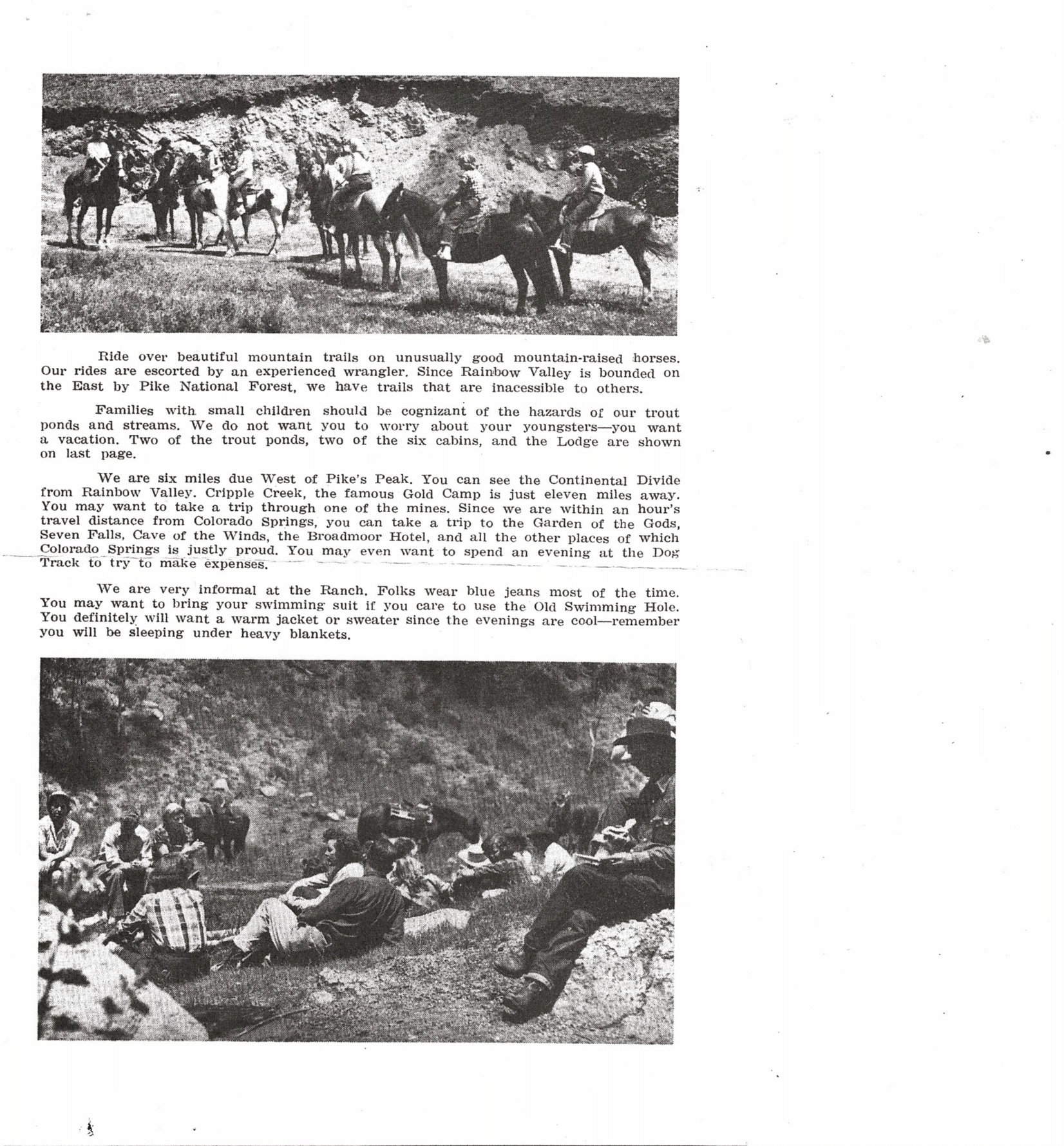
The History of Rainbow Valley Ranch
1870’S
Jim Loshbaugh first homesteaded 320 acres of what is now known as Rainbow Valley, in Teller County, Colorado. At that time the area was known as Jack Rabbit Gulch or Canyon. Notes show that the area was so primitive that Jim ‘was obliged to pack in.’
1890’S
In 1894 the town of Midland was established in Jack Rabbit Gulch. The town was platted by the Oil Creek Mining Co. when the narrow-gauge Midland Terminal Railroad was extended south from the mainline of the Colorado Midland Railroad at Divide toward the gold mines of Cripple Creek and Victor. At this time the town was founded. The railroad reached Midland and terminated there in early 1894. Midland became the railhead for the Cripple Creek area. Ore from the mines was hauled by horse-drawn wagons to the rail head in Midland, then shipped to Colorado Springs for processing into gold. This freight line from Cripple Creek to Midland was founded by the Carlton brothers, one of whom lived in Midland for several years. The ore wagons returned to Cripple Creek with supplies which were off-loaded at Midland. Timbers for shoring the mines were also delivered to Midland, where they were cut and sawed by local lumber mills.
In late 1894 the Midland terminal narrow-gauge railroad was resurveyed into a standard gauge road. The railroad was extended to Gillette and into Victor in 1895. By 1899 it was extended into Cripple Creek. That rail bed is now State Highway 67 as far as Gillette. Midland continued to be the railhead for Cripple Creek until 1899 when it began to decline.
Lumbering in the Midland area was big business from the 1890s until the 1930s. At time there were nine lumber mills in the area. Timber was cut and sawed into lumber for shoring the mines of Cripple Creek. Also, railroad ties were “hacked” (shaped by hand)
cut and sawed into lumber for shoring the mines of Cripple Creek. Also, railroad ties were “hacked” (shaped by hand) for the railroads. Before the railroad, a stagecoach way station was established in Jack Rabbit Gulch to support the Hundley Stage Line, which ran between Divide and Cripple Creek. The wagon and stage road to Cripple Creek was down Four Mile Creek and is presently Teller County route 61. The large rock, about a half mile below the lower pond, was the location of the stage stop. The town of Midland stretched along Four Mile Creek, from the Crags turnoff to where Oil Creek joins Four Mile Creek in the Dome Rock area. The center of the town was the area where the present bar-restaurant of the Rainbow Valley Ranch is located. The town, in its heyday, consisted of some 20 to 30 families. There was the Loshbaugh Hotel located where the present bar-restaurant is situated. There were four saloons and a hotel, McArman’s boarding house, several stores, a school, and a blacksmith shop. There was even a town marshal named Alfred Osborne. The peak population for Midland cannot be found in any of the historical records. However, it is estimated to have been about 400. This figure includes the many lumberjacks, millhands, and miners of the area. Most of these were boarded in area camps. Records show that in 1919 the Midland population was only 10.
There were several gold mines in the area: the Sandbur, the Tracy Hill, and the Schoolhouse Gulch mines. None of them were productive.
In 1885, a large body of Colorado State Militia camped in Midland for several days while on their way to the Cripple Creek and Victor area. They were used to quell labor violence associated with the gold mines of the area.
In 1886 there was a forest fire in the area. A fire started at the head of Putney Gulch near the Lanon Lumber Mill, and it burned over 1500 acres before finally burning out at timberline.
Midland, according to historical notes, was a rip-snortin’ town in the 1890’s. Lumberjacks, miners, and drovers looked for something to do in their off time in the five saloons, and the saloons provided wide-open gambling for them.
In the late 1890’s Jim Loshbaugh was in the news, when he shot at one man and hit another. The incident was over the unwanted courtship of his stepdaughter.
In 1899 the Midland Terminal Railroad reached Cripple Creek, and the town of Midland began its decline. By 1900 only the Loshbaugh Hotel and one store remained. However, Midland continued to be the main source of lumber for the mines in Cripple Creek and for railroad ties until the mid-1930s. The rail siding at Midland was used daily to ship lumber. The Stoner Lumber Mill, just north of the lodge, was one of these mills and was operational until 1980.
1919
Jim Loshbaugh’s 320 acres were sold to Robert Lowrie who tried unsuccessfully to farm the land.
1925
The property was sold to a group of west Colorado Springs businessmen. They started a trout hatchery in the upper three ponds, which were built at that time. The water decree was called the “Silver Spruce Lakes and Pipeline.” This water decree was for “the hatchery and buildings attendant thereto.”
1937
The property was sold to Col. McFadden, a Texas oilman. He tore down all the old buildings that were still standing and made improvements to the property. He built the present guest cabins, the lake lodge, the stables and barns, the machine shop, the lower four ponds, the bar restaurant, and a caretaker’s home, which later became a safes office. The original 320 acres were expanded to 1000 acres and fenced. It was at this time that the name “Rainbow Valley” appeared.
1947 to 1949
The 1000 acres were sold to Charles Westrich and Edward Condon. Within a year, Westrich bought out Condon and proceeded to make Rainbow Valley into a very exclusive guest ranch. Customers had to provide references in order to stay there. The Creek House, just north of the bar-restaurant, was added. In 1949, the last train ran over the Midland terminal line through Rainbow Valley. The railroad was scrapped from Colorado Springs to Cripple Creek.
1957
The ranch was both sold to William Thompson and sold back to by Westrich within a year’s time.
1959
The ranch was sold to Tom Blake, a Texas oilman. Additional acreage was added, making a total of around 1600 acres.
1962 -1964
The ranch was leased to the U.S. Air Force – ENT AFB in Colorado Springs and used as a rest and recreation camp.
1966
The ranch was sold by Tom Blake to Jim Beresford of Denver. He subdivided around 800 acres on both sides of State Highway 67 in 10 units, totaling 553 lots of about one acre each. Their lots were sold to individuals during the period from 1967 to 1970. All the ranch facilities were fully used in promoting the lot sales. Beresford went bankrupt in 1970. He also owned and lost the Fairplay Hotel and the Placer Valley Development north of Fairplay.
1970 -1979
In 1970 the ranch reverted back to Tom Blake. The Rainbow Valley Property Owners’ Association and Water District were formed in 1971 by the property owners of Units 1 through 10. All the buildings in the core area were unoccupied and unmaintained at this time. The RVPOA continued to enforce the area’s covenants, patrol the property, maintain the roads, and to stock and fish the ponds. By 1979 there were 50 homes on the 553 lots. The water district continued to deliver water by tank truck to the homeowners and also secured legal rights to a domestic water supply in 1979.
The ranch was sold twice in 1979, the first time to a group of businessmen from Brookhart’s Lumber Co. in Colorado Springs; Larry Nichols, Tom Watt, and Chuck Brown. The second sale was to Steve and Sandy Limanek, a California couple, who also owned property across Highway 67 from Stoner’s Lumber Yard. No improvements were made during these ownerships.
1981
The property was sold to James Larry Sheerin from San Antonio, Texas doing business as LS Development Corporation with F.B. Brad Howes as his local manager and developer. During 1981 and part of 1982, extensive remodeling and modernization of all facilities occurred including the rental cabins, lake lodge, bar-restaurant, and Creek House. The land office was made into a manager-caretaker home. All of these facilities were opened to the public in July of 1982.
This is a partial history of Jack Rabbit Gulch, Midland, and Rainbow Valley.
1982 - Present Day
The ranch changed hands a few more times over the years, with different ideas proposed for the property, including a plan to repurpose the land to be used by children aspiring to train for the Paralympics. But none of these ideas ever got out of the planning stage.
In 2014, Vicki Alexander bought the property and took great care to rehabilitate structures and infrastructures including the rebuilding of several dams, waterways, pipelines, and water systems essential to the health and safety of the ranch. She also cultivated a community in the valley by leasing some cabins for long-term rental.
After a few years, Alexander started a new chapter of her life that included marriage and relocating out of state. Seeking to pass her legacy on to a fellow visionary who would preserve and protect the ranch’s American Western mountain heritage that honors the long-enduring lifestyle of Teller County residents, she found a kindred spirit in local businessman and philanthropist Tanner Coy.
In the fall of 2022, Coy purchased the property, committed not just to continue restoring the ranch to its glory days, but to showcase the beauty of Rainbow Valley via fishing club memberships, cabin rentals, and a growing event venue for both public and private occasions. This gives visitors a chance to embrace tranquility and forge unforgettable memories, as well as ensuring that the wonders of Rainbow Valley will be enjoyed for generations to come.
















